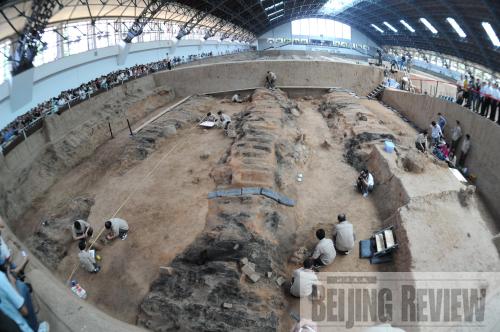|
 |
|
NEW ROUND OF DIGGING: Chinese archeologists work on the third excavation of the Qinshihuang Mausoleum's Pit 1. The project began on June 13, 2009 (JIAO WEIPING) |
Chinese archeologists have come closer to unearthing the hidden story of the terracotta warriors after beginning the third excavation in Pit 1 of the UNESCO World Heritage Site in June. Scientists have found 100 clay warriors and an army officer at the site in Xi'an, capital of northwest China's Shaanxi Province.
Chief archeologist Xu Weihong said the most exciting part about the excavation so far was the discovery of the army officer. He said the life-sized figure was found lying on its stomach behind four chariots.
In spite of a broken head, the statue was largely intact compared with other newly discovered clay figures, most of which were seriously damaged or even broken into fragments, Xu said.
"We can't see its face yet, but the leather gallus on its back is distinct," said Xu, adding that the gallus was typical of the Qin Dynasty (221-206B.C.) army officers.
Xu said the unearthed clay figure was originally painted in different colors. Though the original colors on its body faded with the passing of more than 2,000 years, a patch of the officer's robe suggests it, too, was painted when it was made.
"We need extra care to bring it out of the pit and restore its original color, which may take a few months," Xu said.
The infantry warriors and cavalry units were based on a real army when they were made. The infantry is comprised of ordinary soldiers and officers, which can be distinguished by their costumes, expressions and gestures, said Yuan Zhongyi, an archeologist who has taken part in two previous evacuations.
| 